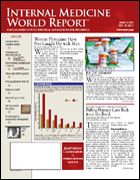Recent Breakthroughs in Breast Cancer Management
From the San Antonio Breast Cancer Symposium
San Antonio—Nearly 10,000 attendees from 80 countries convened for the San Antonio Breast Cancer Symposium. The following reports highlight key developments with important clinical implications.
Rates Continue to Drop
Reversing a decades-old trend, rates of invasive breast cancer dropped dramatically in 2003, possibly as a result of postmenopausal women discontinuing hormone replacement therapy (HRT) due to breast cancer concerns, said Peter M. Ravdin, MD, PhD, of the M.D. Anderson Cancer Center in Houston.
Analysis of the Surveillance Epidemiology and End Results database showed that invasive breast cancer declined by 12% in women aged ≥50 with estrogen receptor-positive tumors. The difference was so astounding that investigators questioned “whether the numbers were real,” Dr Ravdin said.
This drop coincided with a 50% reduction in HRT use in 2002, after the results from the Women’s Health Initiative study linked HRT use to increased risk of breast cancer. The timing of these 2 developments led the investigators to believe that HRT discontinuation rates were responsible for the reduction in breast cancer.
Promising Vaccine for Preventing Recurrence
An investigational vaccine for the prevention of breast cancer recurrence for women with node-positive HER-2—positive breast cancer is showing great promise, according to Col. George Peoples, MD, chief of surgical oncology at Brooke Army Medical Center, Fort Sam Houston, Texas. Use of the E75 peptide from the extracellular domain of HER-2 (dubbed E75; Apthera) reduced cancer recurrence in 5.7% of the vaccine recipients after 20 months compared with 14.1% of the controls. Disease-free survival was 92.5% and 77%, respectively. At 24 months, a 50% reduction in recurrence was seen.
Oral Lapatinib Eradicates Tumor
One of the most promising new agents is the oral drug lapatinib (Tykerb). Like trastuzumab (Herceptin), lapatinib is effective in HER-2—positive tumors, but it has also shown activity against HER-2–positive tumors that have become resistant to trastuzumab.
David Cameron, MD, of Edinburgh General Hospital, Scotland, reported that treatment with lapatinib, combined with the common breast cancer agent capecitabine (Xeloda), nearly doubled the time to disease progression compared with capecitabine alone.
Another study showed that lapatinib plus paclitaxel (Taxol) was very effective in inflammatory breast cancer, an aggressive and rapidly growing tumor. Neoadjuvant treatment with this combination yielded a 77% response rate, with complete responses (ie, no evidence of tumor) in 17% of patients.
“We strongly believe that these preliminary data provide new hope for patients with inflammatory breast cancer, which is very difficult to treat,” said Massimo Cristofanilli, MD, also of the M.D. Anderson Cancer Center.
New Ways to Diagnose Metastases Enhance Survival
A new gene-based diagnostic assessment for lymph node metastases may improve intraoperative pathology and surgical decision-making and reduce the need for second axillary node surgeries, a large multicenter study has shown. The GeneSearch Breast Lymph Node Assay was found to be 10% to 18% more sensitive than frozen section or touch preparation, the traditional intraoperative methods for detecting metastases. The assay samples 50% of the node compared with <5% with standard approaches, said Peter W. Blumencranz, MD, medical director of the Moffitt Morton Plant Cancer Care, Clearwater, Fla.
Improvements in sentinel node-staining techniques allow the detection of occult micrometastases (<0.2 mm) and the even smaller isolated tumor cells in the sentinel nodes. But what is the clinical importance? Emiel Rutgers, MD, PhD, of the Netherlands Cancer Institute, Amsterdam, reported that 19% of patients with micrometastases will have metastases in other axillary nodes, as will 8% of those with isolated tumor cells. Saverio Alberti, MD, PhD, of the University of Chieti, Italy, said that occult metastases may be even more ominous, since most recurrences occur >5 years after surgery. His 8-year follow-up of 702 patients showed a doubling in the risk of poor outcomes in patients with isolated tumor cells, suggesting that these cells may be metastatic at very early stages of disease.
Aromatase Inhibitors Improve Outcomes
Lancet
A new international study presented at the meeting and then published in the (2007; 369:559-570) demonstrated improved overall survival for patients with breast cancer who switched from tamoxifen (Soltamox) to the aromatase inhibitor exemestane (Aromasin) compared with those who remained receiving tamoxifen monotherapy. Additional notable results from the Intergroup Exemestane Study included:
• Women with hormone receptor-positive early-stage breast cancer who switched to exemestane after 2 to 3 years of tamoxifen had a 17% lower risk of dying than with tamoxifen monotherapy
• Patients who switched to exemestane had a 24% lower risk of cancer recurrence, a 17% reduction in metastasis, and a 44% lower incidence of cancer in the other breast.
The findings “show the benefit of sequential administration of tamoxifen and an aromatase inhibitor in patients with endocrine-receptive breast cancer persists for some years after discontinuation with the aromatase inhibitor,” R. Charles Coombes, MD, of the Imperial College, London, England, and colleagues concluded.
